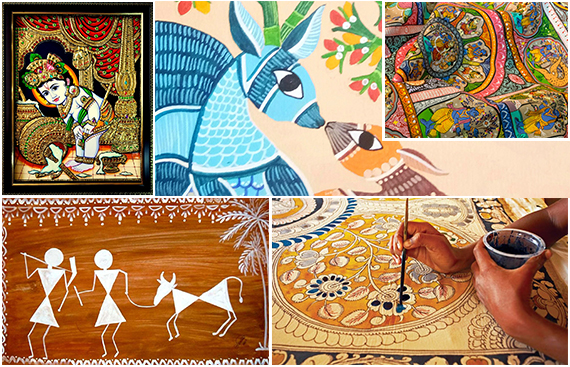5 Ancient Art Forms that Add Color to Indian Culture
By Sangeetha P, Online Content Writer, siliconindia | Thursday, 10 September 2020, 14:45 Hrs

India is globally renowned for its rich diversity that is vividly reflected in the various art form of the country and painting has been one such art form. Indian painting is a fusion of tradition and history, this art form was used to pass on the culture and folklore of India to reach on to the existing as well as upcoming generations. The earliest Indian paintings were rock painting such as petroglyphs found in Bhimbetka rock shelters that were created in the pre-historic times could be 10,000 years old. This Indian art form varies from the different regions across the country such as Mithila paintings of North to Tanjore paintings of the South, and Pattachitra in the East to Warli in the west. Let us quickly glance through five such prominent Indian painting styles.
Tanjore Painting
Tanjore style of painting is the most famous and classical among the other south Indian painting forms. The name of this art is derived from its native Thanjavur (Tanjore) in Tamil Nadu. This painting style's inspiration traces its origin back to 1600 AD by the Nayakas of Thanjavur in the reign of Vijayanagar Rayas. This painting's artistic work, vibrant color, and rich surface make it unique from other forms of Indian paintings. Alongside, this painting form also showcases its exquisite traditional art form that exhibits a rich heritage. Tanjore painting is made using rich and vivid colors alongside glittering gold are overlaid, it is also embedded with glass beads and pieces of various precious gemstones.
These paintings are panel paintings that is been done on wooden planks and thus it is also known as palgai (wooden) padam(painting). Lately, the Tanjore art is done using mirrors, glasses, and canvases, but, the basic idea of decorating it with gold foil makes it unique and deeply rooted in tradition. Hence, this culturally distinct heritage needs to be preserved and carried forward.
Warli Art
Warli is a tribal art form that is mostly done by Adivasi near North Sahyadri Range in western India. This art form was first discovered in the 1970s around the northern outskirts of Mumbai. Yet, there are no records of its exact origins and its roots could be traced back to 10th century A.D. This painting form uses a basic design such as circle, square, and triangle which makes it appear simple and monosyllabic. The circles in the paintings are said to represent the sun and the moon, while the triangle has been derived from mountains and trees. It seems that square has been invented by the human that indicate a piece of land.
These paintings are done on an austere mud base using just one color, white. Yet, it may include occasional dots in red and yellow. The white color used in this art form is obtained from grounding rice into a white powder.
Kalamkari Painting
Kalamkari, an ancient hand painting style whose name has been derived from a Persian word where 'kalam' refers to the pen while 'kari' means craftmanship. This form of painting is done on cotton or silk fabric using a tamarind pen. Also, this painting involves 23 steps of tedious dyeing, bleaching, hand painting, block painting, starching, cleaning, and more. Earlier, painters and folk singers would wander from one village to another narrating various stories from Hindu mythology. These stories have transformed into canvas painting known as kalamkari art, this art form dates back to over 3000 B.C. According to historians, the painting form was first found at the archeological sites of Mohenjo-daro, which was later recognized in the Mughal era. Thus, Mughals promoted this art in the Golconda in the Krishna district of Andhra Pradesh during the 18th century, as a decorative art form on fabric by Britishers in India.
Gond Painting
The Gonds are also an art form done by Adivasi but, the origin goes back to Dravidians whose origins could be traced to the pre-Aryan era. This painting style is prominently found in Madhya Pradesh and its neighboring states. The word Gond derives from Kond which refers to green mountains in the Dravidian language mostly Telugu. About half of the Gonds speak Gondi languages, while the other speaks Indo-Aryan mixed language that also includes Hindi.
This art form is done on mud walls, it has been started in the early 1980s. The traditional materials used in making these paintings are canvas, ink drawings on paper, silkscreen prints, and animated film. They can also be created unprecedented depictions of their natural and mythological worlds, traditional songs, and oral histories. Gond is rich in detailing, color, mystery, and humor. Jangarh Singh Shyam was the first Gond artist to use paper and canvas for his art and his work was recognized and exhibited across the country.
Pattachitra Painting
Pattachitra was originated in the early 12th century and one of the most famous art form of Odisha. The name Pattachitra was derived from Sanskrit where Patta refers to cloth and Chitra means picture thus makes it a fabric painting. This art form is closely related to the Shri Jagannath and other temple traditions in Puri. This painting form is mostly created by Chitrakar community from Puri district known as Raghurajpur, the only village in the country that totally indulges in craftworks such as patta painting, wooden toys, stone carvings, and more. This painting is performed on a gauze-like fine cotton cloth that is coated with white stone powder and gum extracted from tamarind seeds. This surface eases the painting process as the colors used are made naturally. Kaitha tree's gum is used as the main ingredient to make different colors. For instance, to get white color, powdered conch shells are used

